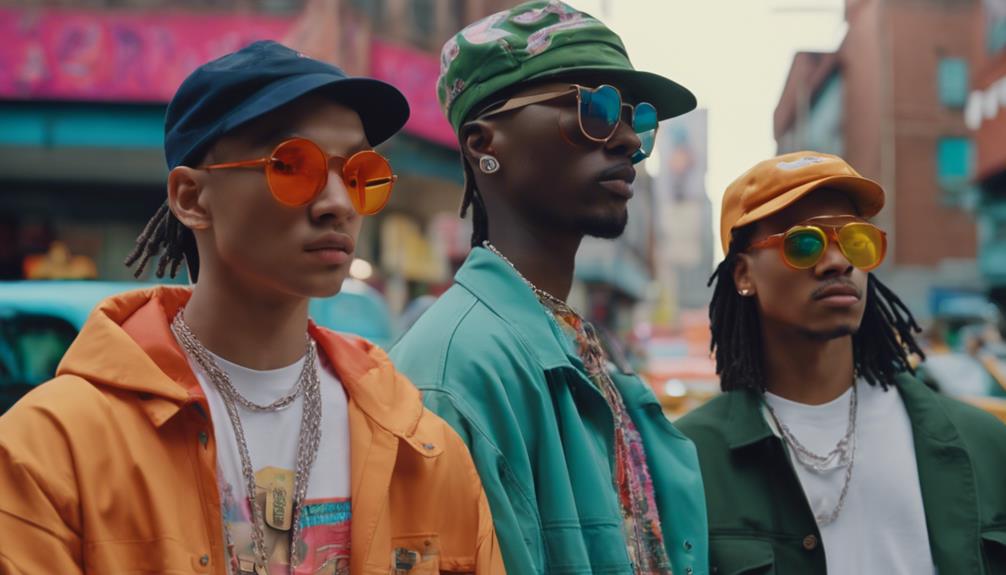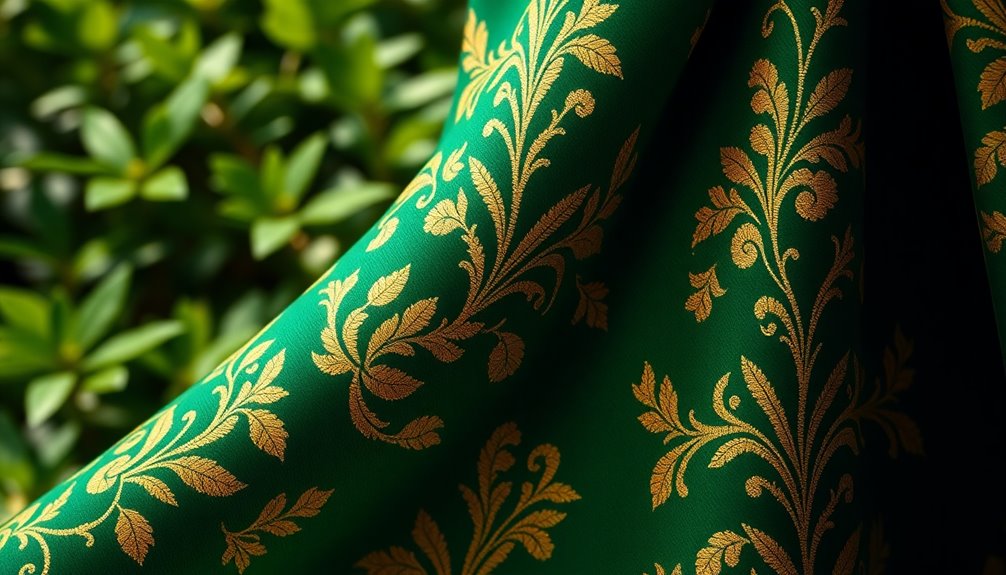In the 1980s, hip hop fashion made a big entrance, showcasing bold and creative styles. Oversized graphic tees, vibrant tracksuits, and baggy jeans were popular everywhere, reflecting the rebellious spirit of the culture. Influential artists like Run-D.M.C. helped popularize sporty looks, especially with their iconic Adidas tracksuits. Gold chains were a must-have accessory, symbolizing status and flair. The fashion of this era emphasized individuality and self-expression, laying the foundation for modern streetwear. If you are eager to embrace that unforgettable vibe, there is much more to discover about the evolution and tips for achieving that classic look!
Key Takeaways
- 80s hip hop fashion emerged from the South Bronx, blending functional clothing with vibrant street culture and artistic expression.
- Iconic elements include oversized clothing, bold graphic prints, tracksuits, denim, leather, and flashy gold chains symbolizing wealth and individuality.
- Run-D.M.C.'s partnership with Adidas revolutionized sportswear in hip hop, highlighting the cultural significance of brands in the fashion scene.
- Modern interpretations of 80s hip hop fashion fuse nostalgia with contemporary trends, featuring collaborations between artists and luxury brands.
Origin and historical background of the fashion trend/style
In the '80s, hip-hop fashion really took off, reflecting the vibrant culture of the streets.
You can't overlook the impact of Run-D.M.C.'s groundbreaking partnership with Adidas, which brought streetwear into the mainstream.
This era marked a shift, as sportswear began to blend seamlessly with urban style, setting the stage for future trends.
Streetwear's Rise in Popularity
Streetwear's rise in popularity traces back to the vibrant hip hop culture of the late 1970s and early 1980s, where functional clothing met creative expression on the streets.
Hip hop fashion emerged in the South Bronx, blending resourceful street style with the needs of dancers and performers. As hip hop artists gained prominence in the 1980s and 1990s, their fashion choices became iconic, with music videos showcasing oversized clothing and heavy gold jewelry, which made bold statements.
The introduction of baggy jeans and oversized t-shirts became synonymous with the gangsta rap movement, especially on the West Coast. Luxury brands began to infiltrate this scene, as artists flaunted high-end items, pushing the boundaries of hip hop fashion. This fusion of streetwear and luxury solidified its influence on mainstream culture.
With each music video, trends evolved, reflecting the creativity and individuality of the artists. Streetwear, once a product of necessity, transformed into a global fashion phenomenon, merging art, music, and style in a way that continues to resonate today.
Run-D.M.C.'S Adidas Partnership
Run-D.M.C.'s groundbreaking partnership with Adidas in the mid-1980s revolutionized the connection between hip-hop culture and sportswear, setting the stage for future collaborations. This iconic group didn't just wear Adidas; they made it a cultural statement. Their hit song 'My Adidas' highlighted their love for the brand, making it synonymous with their style. You could spot them in lace-less Adidas shell-toe sneakers, black fedoras, and thick gold chains—looks that became essential to hip-hop culture and paved the way for streetwear.
In 1986, their performance at the Adidas headquarters in New York City solidified their influence, marking the first major endorsement deal between a hip-hop group and a global sports brand. This partnership opened doors for artists to collaborate with brands, setting a blueprint for future ventures.
The success of Run-D.M.C.'s Adidas collaboration popularized tracksuits and sporty aesthetics, influencing mainstream fashion considerably. Today, you can still see traces of their iconic style in streetwear, proving that their legacy lives on. Run-D.M.C. didn't just change music; they transformed fashion in a way that continues to resonate.
Key Characteristics
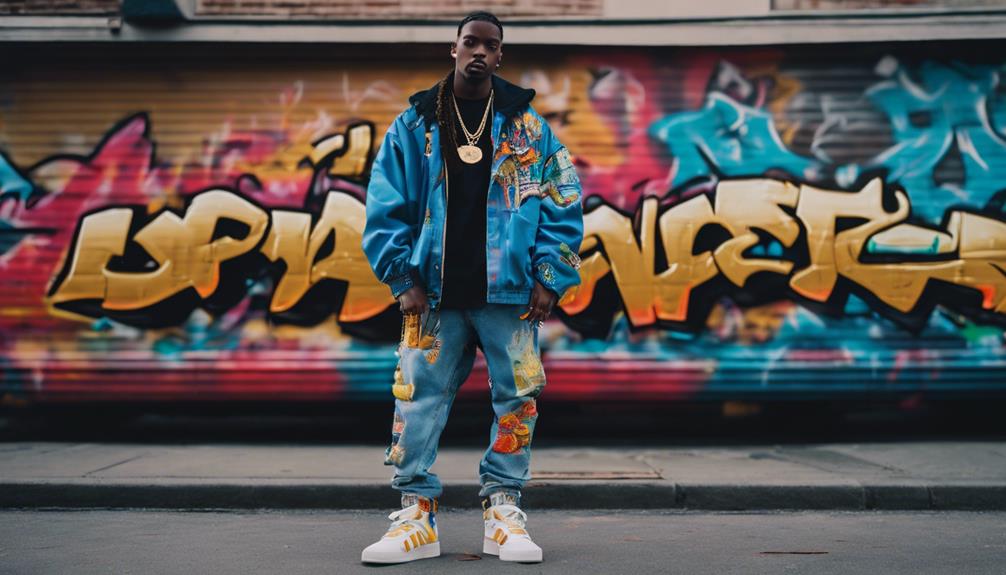
When you think about '80s Hip Hop fashion, bold graphic prints and vibrant colors immediately come to mind.
You'll notice how track suits, denim, and leather pieces were essential, paired with flashy gold chains that made a statement.
These key characteristics not only defined the style but also reflected the culture and attitude of the era.
Bold Graphic Prints and Logos
Bold graphic prints and logos defined 80s hip-hop fashion, showcasing vibrant colors and unique designs that celebrated identity and cultural pride.
You'll notice how oversized clothing became a staple, featuring large logos and bold graphics that made powerful statements about self-expression within hip-hop culture. Brands like Cross Colours and FUBU embraced this aesthetic, ensuring their apparel wasn't just clothing but a canvas for artistic expression.
Groups like TLC rocked bright colors and exaggerated silhouettes, embodying the playful and defiant spirit of the genre. Meanwhile, artists like Run-DMC set trends by donning tracksuits adorned with their names and brand logos, cementing the significance of logo-centric fashion in hip-hop.
This movement went beyond mere style; it transformed into a form of self-expression, allowing artists and fans alike to connect with their roots and showcase their individuality.
As you explore the vibrant landscape of 80s hip-hop fashion, it's clear that bold graphic prints and logos weren't just trends. They were essential elements that shaped the identity of a cultural movement, leaving a lasting impact that still resonates in today's fashion scene.
Denim, Leather, and Vibrant Hues
As you explore 80s hip-hop fashion, you'll find that denim and leather became key elements, embodying a casual yet rebellious spirit that defined the era. Baggy jeans and oversized denim jackets were staples among artists, showcasing a bold aesthetic that resonated with fans. Leather jackets also emerged as iconic pieces, often embellished with patches, symbolizing individuality and defiance.
Vibrant hues played a vital role in this fashion movement, with artists like TLC and Cross Colours championing bright colors and bold patterns. This stood in stark contrast to the monochromatic trends of the time, making a powerful statement about self-expression. Streetwear brands like FUBU and Sean John capitalized on this demand, offering distinctive designs that reflected the vibrant energy of hip-hop culture.
Don't forget the accessories! Gold chains and large hoop earrings complemented denim and leather looks, emphasizing wealth and personal style. Together, these elements created a unique fashion identity that continues to influence modern styles.
Track Suits and Gold Chains
Track suits and gold chains became defining elements of 80s hip-hop fashion, showcasing a blend of comfort, style, and luxury that resonated with the culture's vibrant energy.
Tracksuits, popularized by artists like Run-DMC, featured vibrant colors, bold logos, and relaxed fits, perfectly aligning with the expressive nature of hip hop. You could see these iconic looks paired with classic Adidas sneakers, creating a signature style that still influences fashion today.
Gold chains emerged as essential accessories, symbolizing wealth and status within hip hop culture. Artists frequently wore heavy, flashy pieces, including thick dookie chains, to make bold statements during performances and public appearances. This combination of tracksuits and gold chains represented a unique fusion of streetwear and luxury, reflecting the resourcefulness and creativity of the golden era.
As you explore hip hop fashion, remember that these elements are more than just clothing; they embody a cultural movement that celebrates individuality and self-expression.
The tracksuits and gold chains of the 80s continue to inspire contemporary fashion, proving that style is timeless and ever-evolving.
Modern Interpretation
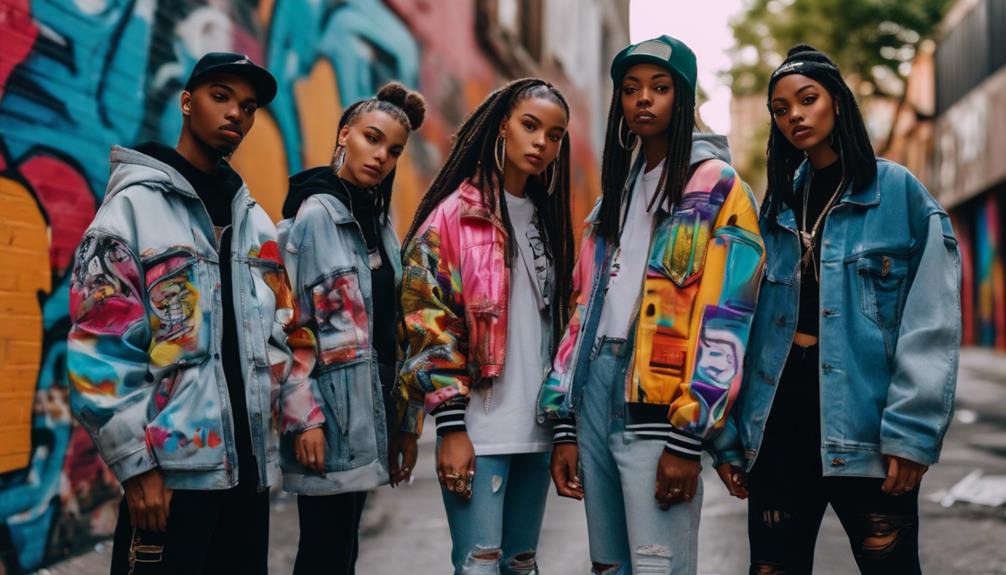
You can see how streetwear has transformed modern fashion by blending iconic hip hop elements with today's trends.
Designers and artists are collaborating in exciting ways, bringing fresh takes on vintage styles.
As you explore this evolution, you'll notice how fashion-forward hip-hop artists continue to shape the scene, making it both nostalgic and innovative.
Streetwear's Influence on Fashion
Drawing inspiration from the bold aesthetics of 80s hip hop, modern streetwear reinterprets oversized silhouettes and vibrant colors to create a fresh, nostalgic style. You'll notice that this contemporary movement retains the essence of hip-hop fashion from the 1980s and 1990s, merging it with today's trends.
Streetwear thrives on graphic logos and playful designs, elements that connect the past with the present. Collaborations between hip hop artists and luxury brands have become a defining feature of this evolution. For example, Kanye West's Yeezy line with Adidas showcases how streetwear can seamlessly blend with high fashion, pushing the boundaries of traditional luxury.
Influential designers like Virgil Abloh have played key roles in bridging this gap, proving hip hop culture's ongoing impact on mainstream fashion. The rise of social media has further amplified streetwear's reach, enabling you to witness global trends set by artists.
Today's streetwear also incorporates athleisure and sustainable practices, reflecting an evolution that remains rooted in hip hop's cultural expressions. This fusion not only honors the past but paves the way for future interpretations of style.
Streetwear Icons and Collaborations
Modern streetwear icons like Pharrell Williams and A$AP Rocky are redefining fashion by merging hip-hop aesthetics with high-end collaborations that resonate with fans and set new trends.
These hip-hop artists work closely with luxury fashion brands like Chanel and Gucci, creating pieces that not only elevate streetwear but also pay homage to classic 90s hip-hop styles. The influence of artists like Kanye West, with his Yeezy line, demonstrates how collaborations can become cultural phenomena, selling out instantly and showcasing the powerful intersection of music and fashion.
Contemporary artists such as Cardi B and Beyoncé continue this trend, partnering with Reebok and Adidas to drive consumer interest and reshape brand identity.
The nostalgic revival of 90s styles through modern collections from brands like FUBU and Sean John captures the essence of hip-hop's golden era while appealing to new audiences.
Social media amplifies the impact of these streetwear collaborations, allowing you to engage with your favorite artists directly and catch limited-edition drops. This sense of urgency and exclusivity fuels the excitement surrounding modern streetwear, making it an integral part of today's fashion landscape.
Fashion-Forward Hip-Hop Artists
Fashion-forward hip-hop artists are reshaping the industry by seamlessly blending street style with high fashion, creating unique looks that challenge traditional norms.
Pharrell Williams stands at the forefront, known for merging streetwear with luxury, as seen in his collaborations with brands like Chanel and Adidas. His iconic looks often redefine what it means to be fashionable in hip-hop.
A$AP Rocky also pushes boundaries, effortlessly mixing vibrant prints with high-end pieces like Gucci's babushka scarf, influencing contemporary fashion.
Cardi B showcases her bold personality through partnerships with Reebok, embodying a fusion of high fashion and street style that resonates with her audience.
Then there's Lil Nas X, who challenges gender norms in hip-hop by donning avant-garde outfits that blend elements of menswear and womenswear, making a statement about identity and expression.
Finally, Tyler, the Creator popularizes skate-inspired fashion while embracing luxury collaborations with Golf Wang, proving that casual aesthetics can meet high-end tailoring.
Together, these artists illustrate the dynamic evolution of hip-hop fashion, inspiring a new generation to explore and redefine their own style.
Styling Tips
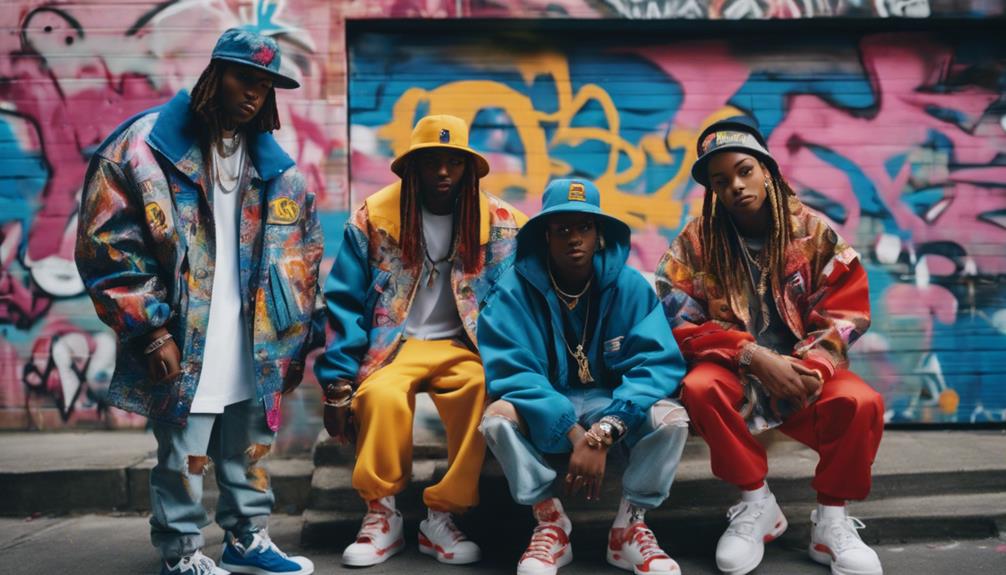
When you're looking to nail that '80s hip hop vibe, classic sneakers and caps are essential.
Layering streetwear pieces creatively with graphic tees can elevate your look and give it that authentic edge.
Don't forget to mix and match styles to truly express your unique take on this iconic fashion era.
Classic Sneakers and Caps
Looking to nail that classic 80s hip hop vibe? Start with a pair of iconic sneakers and a stylish cap that reflects your personality.
Classic sneakers like Adidas Superstars or Nike Air Force 1s are essential; they not only offer comfort but also make a bold fashion statement. Pair them with baggy jeans for that true hip hop culture aesthetic.
Don't forget about caps! Baseball caps, especially when worn backwards or tilted, are a must-have accessory. Brands like New Era and Mitchell & Ness provide options that capture the essence of hip hop. You can opt for oversized caps or snapbacks that showcase your favorite logos, adding an extra layer of urban flair to your outfit.
If you want to express your individuality, consider colorful sneakers from brands like PUMA or Reebok. These vibrant styles are perfect for turning heads and can easily elevate your look.
Layered Streetwear Ensembles
Master the art of layering by combining oversized tees with baggy jackets or hoodies to create a relaxed silhouette that embodies the essence of 80s hip hop style.
To achieve the perfect layered streetwear look, start with a vibrant oversized tee as your base. Pair it with a baggy jacket, like an iconic tracksuit or a denim piece, to add that classic street vibe.
Don't forget about your bottoms—opt for baggy pants or cargo styles that enhance comfort and style. Bright colors are key, so mix and match bold hues to make a statement.
Signature accessories are essential to complete your ensemble; think thick gold chains, snapback hats, and colorful sneakers from brands like Adidas or Puma.
Experiment with patterns and textures, channeling the individuality popularized by groups like TLC. Layering allows you to express your personal style while paying homage to hip-hop's rich history.
Layering Graphic Tees Creatively
Layering graphic tees adds a unique flair to your outfit, allowing you to showcase your personality through bold designs and creative combinations. To master this look, start with an oversized graphic tee that embodies the relaxed vibe of hip-hop fashion. Layer it over a fitted long-sleeve shirt for a dynamic silhouette that catches the eye.
Mix and match different lengths, like a cropped graphic tee over a longer shirt, to give your ensemble a contemporary twist. Color contrast is key—choose tees with vibrant prints that pop against darker or neutral layers, reminiscent of the bold aesthetics of 90s hip-hop culture.
Don't forget the accessories! Elevate your layered graphic tee look with statement pieces like gold chains, bucket hats, or chunky sneakers, reflecting the style elements popularized by iconic artists.
Whether you're going for a nostalgic or modern vibe, layering graphic tees creatively can transform your outfit into a fashionable statement. With these tips, you'll effortlessly blend comfort and style, making your mark in the world of hip-hop fashion.
Shopping Guide
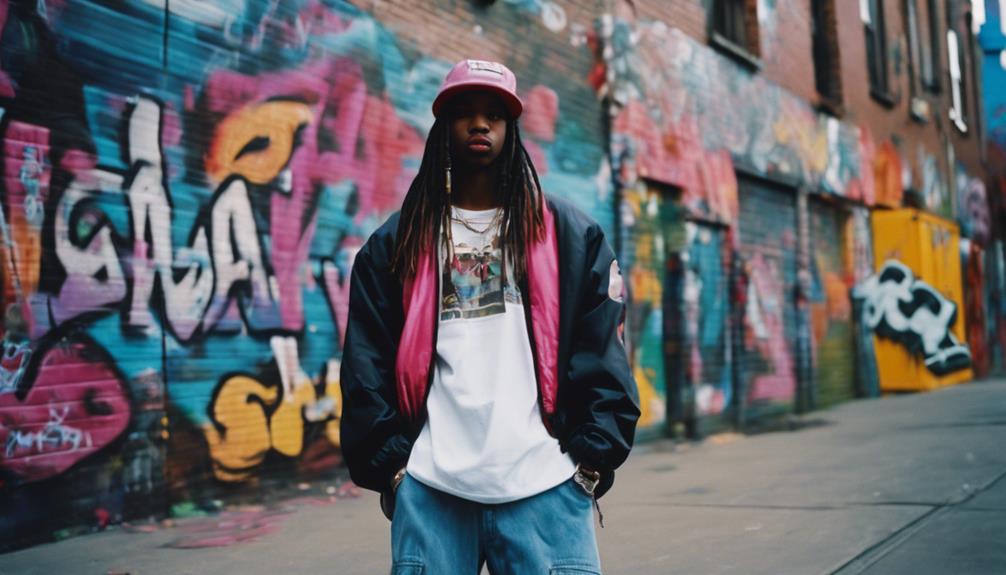
To nail the essence of 80s hip hop fashion, you'll want to hunt down iconic pieces like oversized graphic tees and tracksuits, which are often hidden gems in thrift stores and vintage shops.
Start by exploring local spots where you can find these staples that define the era.
Don't forget to check out classic sneakers, like Adidas Superstars and Puma Clyde, to complete your look. These shoes not only provide comfort but are also a nod to hip hop's rich history.
When accessorizing, go bold with jewelry—think large gold chains and hoop earrings that were signature statements of the time. These pieces can elevate any outfit and give it that authentic vibe.
Additionally, seek out brands with roots in hip-hop culture, such as FUBU and Cross Colours. Their retro collections pay homage to the Golden Era, making them perfect additions to your wardrobe.
Upcycled Vintage Clothing Techniques
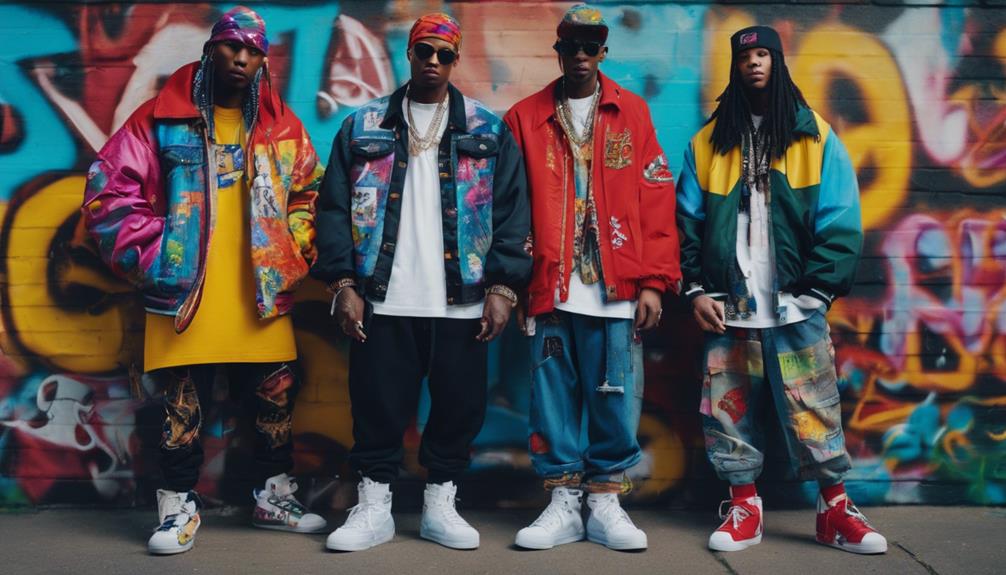
When you think about upcycled vintage clothing, consider how you can repurpose old streetwear pieces into fresh styles.
Using patchwork techniques, you can transform worn garments into unique statements that reflect your individuality.
This approach not only revives classic 80s hip hop vibes but also contributes to a more sustainable fashion scene.
Repurposing Old Streetwear Pieces
Repurposing old streetwear pieces not only gives garments a fresh identity but also contributes to a more sustainable fashion landscape. As you immerse yourself in the world of upcycled clothing, you'll discover that it's a creative way to breathe new life into your vintage finds. Whether it's an old t-shirt from the 80s or a pair of baggy jeans from the 90s hip-hop eras, repurposing allows you to transform these items into something entirely unique.
Thrift culture has fueled a growing demand for sustainable fashion, encouraging you to experiment with various upcycling techniques. You can cut and sew vintage tees into trendy crop tops or mix different fabrics to create a patchwork masterpiece. Adding artistic elements like embroidery or fabric paint can also elevate your designs, making them one-of-a-kind statements.
DIY upcycling workshops are popping up everywhere, empowering you to take matters into your own hands. Plus, collaborations between hip-hop artists and sustainable fashion brands often feature upcycled clothing lines, emphasizing the importance of creativity and resourcefulness in modern streetwear culture.
Patchwork Techniques for Streetwear
Patchwork techniques in streetwear allow you to transform discarded vintage clothing into unique statement pieces that reflect your personal style and creativity. By embracing upcycling, you can take remnants of old garments and craft something entirely new, contributing to sustainability in the fashion industry. This resourceful approach aligns perfectly with hip-hop culture, which celebrates creativity and self-expression.
Incorporating patchwork techniques into your wardrobe means blending various textures, colors, and patterns, making your outfit stand out in a crowd. Many notable designers within the hip-hop community, like Off-White and A Bathing Ape, have adopted these methods, showcasing their influence on contemporary streetwear. By using patchwork, you're not just making a fashion statement; you're also participating in a movement that reduces waste and promotes eco-friendly practices.
Whether you're sewing together denim scraps or mixing prints from thrift finds, the possibilities are endless. Each piece you create tells a story and reflects your individuality, embodying the vibrant and eclectic spirit of hip-hop culture. So, grab your sewing kit and start exploring the exciting world of patchwork techniques today!
Cultural Impact
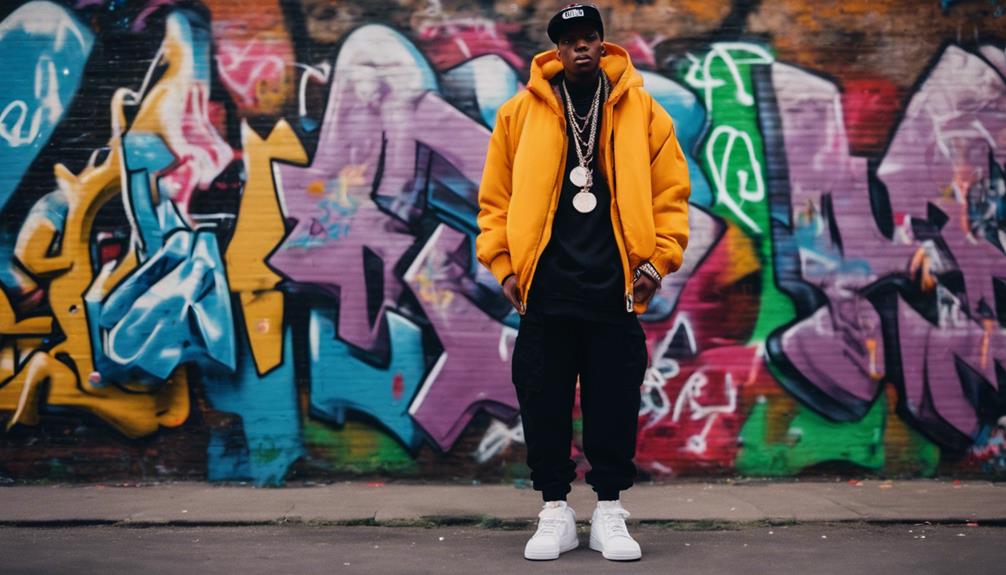
When you look at the cultural impact of '80s hip-hop fashion, you'll see how collaborations in film and music reshaped style.
Artists not only influenced fashion trends but also highlighted civil rights themes, pushing for representation and authenticity.
This blend of art and activism created a powerful narrative that continues to resonate today.
Film and Music Collaborations
The dynamic interplay between film and music in the 80s not only shaped hip-hop culture but also left a lasting mark on fashion trends that still resonate today.
Iconic collaborations, like Run-D.M.C.'s partnership with Adidas in the 'My Adidas' campaign, solidified hip-hop's influence on mainstream fashion. Films such as 'Beat Street' and 'Wild Style' showcased hip-hop fashion, introducing streetwear styles that featured graffiti-inspired clothing and B-boy aesthetics. These visual mediums helped elevate the importance of fashion within the hip-hop community during the Golden Era.
The music video for TLC's 'Ain't 2 Proud 2 Beg' popularized oversized clothing and vibrant colors, embodying the playful spirit of the time. Meanwhile, N.W.A.'s 'Straight Outta Compton' film highlighted the gangsta rap aesthetic, showcasing baggy jeans and flannels that defined West Coast hip-hop fashion.
These film and music collaborations not only influenced what you wore but also how you perceived hip-hop culture. Even today, artists like Pharrell Williams continue to push boundaries, working with brands like Moncler and Adidas, proving the ongoing cultural impact of hip-hop on the fashion industry.
Civil Rights and Hip-Hop Fashion
Hip-hop fashion serves as a vibrant canvas for self-expression, reflecting the struggles and aspirations of marginalized communities shaped by the Civil Rights Movement and its legacy.
This bold style emerged as a response to socioeconomic challenges, with oversized clothing and gold chains symbolizing resistance against racial stereotypes. Designers like Dapper Dan played an essential role in this movement, blending luxury elements with streetwear, which bridged the gap between high fashion and the rich cultural narratives of African-American communities.
Through its distinct styles, hip-hop fashion promoted inclusivity, redefining traditional beauty standards while challenging norms of masculinity and femininity. The visibility of hip-hop in media during the Golden Era further elevated cultural pride, inspiring future generations to embrace their identity through fashion. Artists showcased their heritage, creating a sense of belonging and empowerment within their communities.
Ultimately, hip-hop fashion goes beyond mere clothing; it's a reflection of resilience and creativity, rooted in the civil rights struggle. As you explore this world, you'll see how it continues to influence not just fashion but also societal change, inspiring countless individuals to express themselves authentically and proudly.
Frequently Asked Questions
What Is Considered the Golden Era of Hip Hop?
The Golden Era of hip hop, from the late 1980s to mid-1990s, showcases influential artists, innovative sounds, and cultural shifts. You'll discover how this period shaped the genre's identity and left a lasting impact.
What Is the Traditional Clothing for Hip Hop?
Traditional hip-hop clothing features oversized shirts, baggy pants, and comfortable sneakers. You'll often see tracksuits and baseball caps in vibrant colors, along with accessories like gold chains, reflecting the unique street culture and self-expression.
What Are the Characteristics of Hip Hop Fashion?
Hip hop fashion's characterized by oversized clothing, bold colors, and signature accessories. You'll notice baggy pants, graphic tees, and sneakers, all reflecting a blend of comfort, self-expression, and cultural identity that defines the style.
What Is the Original Hip Hop Style?
The original hip-hop style emerged in the 1970s, focusing on comfort and functionality. You'd see oversized shirts, baggy pants, and iconic sneakers, all reflecting the vibrant street culture of the South Bronx community.
What Influence Did 80s Hip Hop Fashion Have on Asap Rocky’s Style?
When it comes to asap rocky iconic fashion styles, there’s no denying the impact of 80s hip hop fashion on his style. The bold colors, oversized silhouettes, and flashy accessories of the 80s era heavily influenced Rocky’s iconic fashion choices. His unique blend of old-school swagger and modern flair is a testament to the lasting influence of 80s hip hop fashion.
Conclusion
In the vibrant world of '80s hip hop fashion, you've discovered a style that celebrates individuality and creativity.
By embracing its key characteristics and incorporating modern interpretations, you can effortlessly channel that iconic vibe.
Remember, it's all about expressing yourself, so mix and match with confidence!
Immerse yourself in thrift stores for unique finds, and don't shy away from upcycling.
Ultimately, the cultural impact of this era continues to inspire, making it a timeless source of style.
